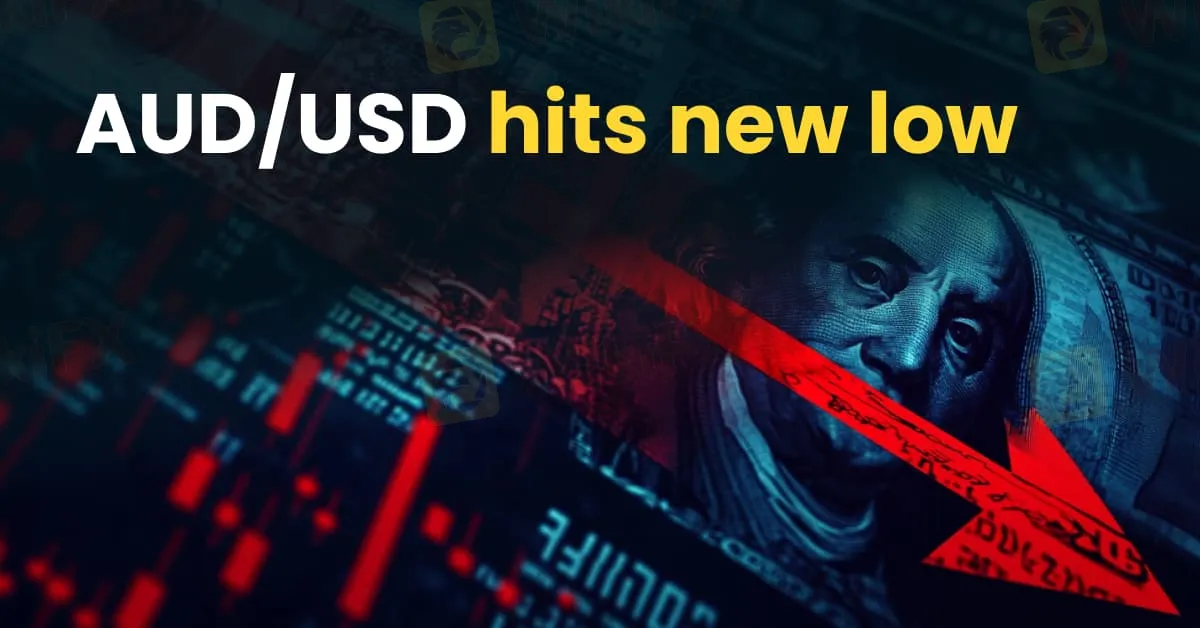简体中文
繁體中文
English
Pусский
日本語
ภาษาไทย
Tiếng Việt
Bahasa Indonesia
Español
हिन्दी
Filippiiniläinen
Français
Deutsch
Português
Türkçe
한국어
العربية
AUD/USD Hits New Lows as Panic Selling Unfolds Amid Robust U.S. Jobs Report
Abstract:The Australian dollar tumbled to a fresh multi-year low of 0.5932 against the U.S. dollar, breaking through several key technical support levels and triggering widespread panic selling in the currency markets. The sharp decline comes at a time when mixed signals from economic data and monetary policy expectations are creating a volatile environment for traders and investors alike.

The Australian dollar tumbled to a fresh multi-year low of 0.5932 against the U.S. dollar, breaking through several key technical support levels and triggering widespread panic selling in the currency markets. The sharp decline comes at a time when mixed signals from economic data and monetary policy expectations are creating a volatile environment for traders and investors alike.
Technical Breakdown Sparks Market Sell-Off
The AUD/USD pairs plunge below 0.5932 marks the lowest level in recent years, as the Australian dollar succumbed to selling pressure on multiple fronts. Technical analysts noted that the pair breached several important support levels, prompting a cascade of stop-loss orders and panic selling. Market participants reacted swiftly, with many traders rushing to exit positions as risk aversion took hold. The breakdown has further exacerbated concerns that the underlying momentum could force the currency lower if investor sentiment fails to stabilize.
Strong U.S. Jobs Data Raises Mixed Signals
Adding to the complex economic landscape, the latest U.S. Labor Department data revealed that nonfarm payrolls surged by 228,000 in March—significantly outperforming Februarys revised gain of 117,000. This robust job creation suggests that the U.S. labor market remains strong despite ongoing global economic uncertainties. However, the report also showed that the unemployment rate ticked up slightly to 4.2% from 4.1%, surpassing market expectations and hinting at potential headwinds for the U.S. economy.
Fed Rate-Cut Expectations Remain Intact
Despite the encouraging employment numbers, market sentiment appears to be focused on the prospect of further monetary easing. Investors have already priced in a total of 100 basis points of Fed rate cuts over the course of the year, and some analysts do not rule out the possibility of an additional (fifth) rate cut. The expectation of lower borrowing costs is seen as a counterbalance to the strong jobs data, reinforcing the belief that accommodative monetary policy will prevail in the coming months.
Implications for Investors
For investors, the confluence of a sharply weakening Australian dollar and strong U.S. labor market data creates a paradox. On one hand, the robust U.S. jobs report supports the economic fundamentals of the dollar, while on the other, a deteriorating AUD/USD technical picture suggests that risk-off sentiment remains prevalent in global currency markets.
A weaker Australian dollar could benefit export-oriented Australian companies by making their goods more competitive overseas. Conversely, for Australian consumers and businesses that rely on imported products, the lower exchange rate could lead to higher costs and increased inflationary pressures. Moreover, if the Fed continues its course of rate cuts amid persistent economic uncertainty, further depreciation of risk-sensitive currencies like the Aussie might be on the horizon.
Looking Ahead
Analysts advise that traders and investors closely monitor upcoming economic indicators, including inflation readings and central bank commentary, to gauge the trajectory of both the U.S. economy and the AUD/USD pair. With technical weaknesses now clearly evident and monetary policy expectations still leaning toward further easing, market volatility is likely to persist in the near term.
In summary, while the U.S. labor markets resilience provides a positive backdrop for the dollar, the pronounced technical breakdown in the AUD/USD pair underscores the challenges facing the Australian currency. Investors are left balancing between the strong fundamentals of the U.S. economy and the caution warranted by a risk-off environment in global currency markets.

Disclaimer:
The views in this article only represent the author's personal views, and do not constitute investment advice on this platform. This platform does not guarantee the accuracy, completeness and timeliness of the information in the article, and will not be liable for any loss caused by the use of or reliance on the information in the article.
Read more

2024 AI Ad-Blocking Performance Revealed
AI takes the lead in ad screening, blocking billions of harmful ads and safeguarding online safety worldwide.

Fed Caught in a Bind: Inflation and Economic Pressures Mount
Stubborn inflation and slowing growth leave the Fed stuck between a rock and a hard place, with limited room to maneuver.

Mazi Finance Unveils $30 No‑Deposit Forex Bonus for New Traders
Mazi Finance is rolling out an enticing opportunity for aspiring Forex traders: a $30 No Deposit Bonus simply for signing up. This risk-free bonus allows newcomers to explore real market conditions and hone their trading skills, without parting with a single dollar of their capital.

SkyLine Guide 2025 Thailand Officially Launched: Judging Panel Formation Underway
Looking back at 2024, the successful debut of SkyLine Guide Thailand not only earned widespread industry recognition and high acclaim but also demonstrated WikiFX's unwavering commitment to enhancing forex trading security and market transparency.
WikiFX Broker
Latest News
"Rate & Reward: Broker Review Contest"
FSRA Sanctions Hayvn Group and CEO for Regulatory Breaches and Misleading Conduct
2024 AI Ad-Blocking Performance Revealed
Why Are More Regulated Brokers Providing Free VPS Services?
SkyLine Guide 2025 Thailand Officially Launched: Judging Panel Formation Underway
CySEC Issues Investor Alert on Unauthorized Financial Websites
US Forex Brokers Hold Over $500 Million in Client Funds
Japan’s Economy Under High Tariffs: A Gloomy Outlook
Hong Kong Warns of CBEX Group Fraud Amid Nigerian Outrage
PU Prime Teams Up with AFA to Champion Excellence in Football and Trading
Currency Calculator


